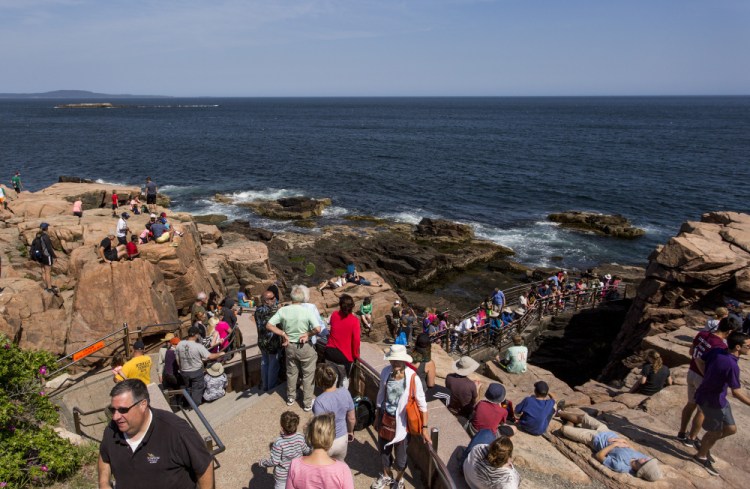Tourist visits to Maine reached a six-year high last year, but growth slowed to a crawl, raising concern the state has to do more to stand out in a competitive vacation market.
There were about 37 million tourist visits to the state in 2018, just 1 percent more than the year before, according to an annual visitation survey commissioned by the Maine Office of Tourism.
In the four years before 2016, annual visitation to Maine grew an average 6 percent a year. In 2017, that growth slowed to 2.5 percent increase.
Last year’s anemic growth is a warning sign for Maine to retool its tourism marketing and management approach, said Steve Lyons, executive director of the state tourism office.
“It is something we are going to take a look at,” Lyons said. “Is it a concern? A little bit.”
Tourists that made the trip spent big, however. Direct tourism expenditures reached $6.2 billion in 2018, a 3 percent increase from the year before, according to state figures. The tourism economy supports about 109,500 jobs, roughly one in every six jobs in the state.
In the last five years the state has pushed to identify the type of customers likely to visit, designed a slick marketing campaign and targeted advertising in markets outside New England, particularly Maryland, New Jersey, Pennsylvania and Washington, D.C.

That strategy has worked to generate new tourism customers – almost 3.3 million first-time visitors came to Maine since 2013. It has also driven up revenue, since people who travel from the mid-Atlantic tend to stay longer and spend more, Lyons said.
The Maine Office of Tourism is targeting Atlanta and Detroit with ad campaigns this year, hoping those new markets will generate new visitors.
The state office of tourism exceeded three of its four five-year goals – at least $6 billion total tourist spending, increased restaurant and lodging taxable sales by $500 million and boosted the number of first-time visitors by 500,000.
It fell far short of attracting 3.7 million businesses-related visitations, however, only getting 2.2 million business trips last year.
To keep growing, Maine will have to differentiate itself and entice new visitors in an increasingly competitive global market, Lyons said.
Travel preferences now trend toward spontaneity and new experiences, so visitors who loved Maine the first time for an impromptu weekend are likely to look for the next adventure, instead of coming back next year.
“There are so many places to go,” Lyons said. “Now people can say ‘I’ve been there, done that, now I want to do something different.’ ”
In its new five-year plan the state plans to leverage Maine’s authentic brand and encourage tourists to visit the state for experiences, not just a vacation, Lyons said.
Just as important is communication with businesses and local communities. While the state has done a good job marketing the state, it has not been as successful explaining why tourism is important to economic development or the state tourism office’s role to support businesses, according to its newest five-year strategic plan.
As a result “Many tourism businesses feel both uninformed and unheard,” the office of tourism reported.
The office also plans an evaluation of the state’s tourism marketing bureaucracy. Maine is divided into seven regions marketed by a nonprofit organization.
Those groups were supposed to grow into self-sustaining organizations, but have mostly remained small, part-time offices dependent on annual grants from the state, according to the report. Some businesses are unaware these offices exist or what they do to market the region.
“There is consensus that the regional structure needs improving, so that dollars invested into regional marketing are spent more effectively,” the report stated.
Overall, the Maine Office of Tourism suggests the state needs to better coordinate disparate marketing efforts run by local businesses and organizations.
“It is evident that there is good work being done by many chambers of commerce, convention and visitors bureaus and individual tourism businesses,” the five-year plan said. “But without a stronger single unifying organization, efficiencies are lost and resulting work is duplicative and labor-intensive.”
Chris Fogg, the president and CEO of the Maine Tourism Association, agrees the state needs to streamline its approach.
The decline in tourism growth the last two years should be a wake-up call that Maine is playing in a hyper-competitive tourism market and needs to band together to keep up and stand out, Fogg added.
“I think we have an opportunity to grow our state, but we need to do a better job working together to get a message out in a more collaborative way.”
Peter McGuire can be contacted at 791-6325 or at:
pmcguire@pressherald.com
Send questions/comments to the editors.




Success. Please wait for the page to reload. If the page does not reload within 5 seconds, please refresh the page.
Enter your email and password to access comments.
Hi, to comment on stories you must . This profile is in addition to your subscription and website login.
Already have a commenting profile? .
Invalid username/password.
Please check your email to confirm and complete your registration.
Only subscribers are eligible to post comments. Please subscribe or login first for digital access. Here’s why.
Use the form below to reset your password. When you've submitted your account email, we will send an email with a reset code.